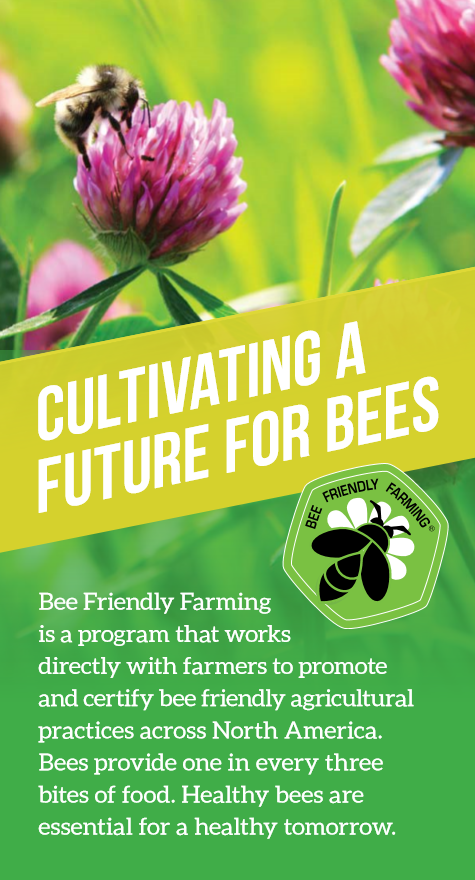BFF Criteria
- Offer forage providing good nutrition for bees on at least 3% of land. Forage can be temporary, including cover crops.1–6
- Provide bloom of different flowering plants throughout the growing season, especially in early spring and late autumn. There is no minimum land coverage for seasonal bloom.7–18
- Offer clean water for bees if not inhibited by government mandated water restrictions.19–21
- Provide permanent habitat for nesting through features such as hedgerows, natural brush, buffer strips, or bare ground.7,8,22,23
- Practice Integrated Pest Management (IPM); reduce or eliminate the use of chemicals.7,8,15,16,24,25
BFF Criteria References (Partial List)
- Holland JM, Storkey J, Lutman PJW, Henderson I, and Orson J, The Farm4Bio project: managing uncropped land for biodiversity, 13.
- Holland JM, Storkey J, Lutman PJW, Henderson I, and Orson J, Managing uncropped land in order to enhance biodiversity benefits of the arable farmed landscape: The Farm4bio project, 97.
- Tscharntke T, Steffan-Dewenter I, Kruess A, and Thies C, CONTRIBUTION OF SMALL HABITAT FRAGMENTS TO CONSERVATION OF INSECT COMMUNITIES OF GRASSLAND–CROPLAND LANDSCAPES *, Ecological Applications 12:354–363 (2002).
- Kleijn D, Rundlöf M, Scheper J, Smith HG, and Tscharntke T, Does conservation on farmland contribute to halting the biodiversity decline?, Trends in Ecology & Evolution 26:474–481 (2011).
- Scheper J, Holzschuh A, Kuussaari M, Potts SG, Rundlöf M, Smith HG, et al., Environmental factors driving the effectiveness of European agri-environmental measures in mitigating pollinator loss - a meta-analysis, ed. by Gomez J, Ecol Lett 16:912–920 (2013).
- Klein A-M, Brittain C, Hendrix SD, Thorp R, Williams N, and Kremen C, Wild pollination services to California almond rely on semi-natural habitat: Wild pollination services to California almond, Journal of Applied Ecology:no-no (2012).
- Kovács-Hostyánszki A, Espíndola A, Vanbergen AJ, Settele J, Kremen C, and Dicks LV, Ecological intensification to mitigate impacts of conventional intensive land use on pollinators and pollination, ed. by Irwin R, Ecol Lett 20:673–689 (2017).
- Dicks LV, Viana B, Bommarco R, Brosi B, Arizmendi M del C, Cunningham SA, et al., Ten policies for pollinators, Science 354:975–976 (2016).
- Garibaldi LA, Carvalheiro LG, Leonhardt SD, Aizen MA, Blaauw BR, Isaacs R, et al., From research to action: enhancing crop yield through wild pollinators, Frontiers in Ecology and the Environment 12:439–447 (2014).
- Garibaldi LA, Steffan‐Dewenter I, Kremen C, Morales JM, Bommarco R, Cunningham SA, et al., Stability of pollination services decreases with isolation from natural areas despite honey bee visits, Ecology Letters 14:1062–1072 (2011).
- A global quantitative synthesis of local and landscape effects on wild bee pollinators in agroecosystems - Kennedy - 2013 - Ecology Letters - Wiley Online Library, https://onlinelibrary.wiley.co... [accessed 9 November 2020].
- Kleijn D, Winfree R, Bartomeus I, Carvalheiro LG, Henry M, Isaacs R, et al., Delivery of crop pollination services is an insufficient argument for wild pollinator conservation, Nature Communications 6:7414, Nature Publishing Group (2015).
- Lichtenberg EM, Kennedy CM, Kremen C, Batáry P, Berendse F, Bommarco R, et al., A global synthesis of the effects of diversified farming systems on arthropod diversity within fields and across agricultural landscapes, Global Change Biology 23:4946–4957 (2017).
- Morandin LA and Kremen C, Hedgerow restoration promotes pollinator populations and exports native bees to adjacent fields, Ecological Applications 23:829–839 (2013).
- Morandin LA, Long RF, and Kremen C, Pest Control and Pollination Cost–Benefit Analysis of Hedgerow Restoration in a Simplified Agricultural Landscape, J Econ Entomol 109:1020–1027, Oxford Academic (2016).
- Morandin L, Long R, Pease C, and Kremen C, Hedgerows enhance beneficial insects on farms in California’s Central Valley, California Agriculture 65:197–201, University of California, Agriculture and Natural Resources (2011).
- Ricketts TH, Regetz J, Steffan‐Dewenter I, Cunningham SA, Kremen C, Bogdanski A, et al., Landscape effects on crop pollination services: are there general patterns?, Ecology Letters 11:499–515 (2008).
- Havens K and Vitt P, The Importance of Phenological Diversity in Seed Mixes for Pollinator Restoration, Natural Areas Journal 36:531 (2016).
- Nicolson SW, Water homeostasis in bees, with the emphasis on sociality, Journal of Experimental Biology 212:429–434 (2009).
- Ferry C and Corbet SA, Water Collection by Bumble Bees, Journal of Apicultural Research 35:120–122 (1996).
- Feeding Honey Bees, https://pollinators.msu.edu/re... [accessed 9 November 2020].
- Menz MHM, Phillips RD, Winfree R, Kremen C, Aizen MA, Johnson SD, et al., Reconnecting plants and pollinators: challenges in the restoration of pollination mutualisms, Trends in Plant Science 16:4–12 (2011).
- Ferreira PA, Boscolo D, and Viana BF, What do we know about the effects of landscape changes on plant–pollinator interaction networks?, Ecological Indicators 31:35–40 (2013).
- Larson JL, Dale A, Held D, McGraw B, Richmond DS, Wickings K, et al., Optimizing Pest Management Practices to Conserve Pollinators in Turf Landscapes: Current Practices and Future Research Needs, Journal of Integrated Pest Management 8 (2017).
- Pecenka JR, Ingwell LL, Foster RE, Krupke CH, and Kaplan I, IPM reduces insecticide applications by 95% while maintaining or enhancing crop yields through wild pollinator conservation, Proceedings of the National Academy of Sciences of the United States of America 118:44 (2021).
